
Kangra tea is a tea from the Kangra district in Himachal Pradesh, India. Both black tea and green tea have been produced in the Kangra Valley since the mid-19th century. Kangra tea was given the Geographical Indication status in 2005.

Kangra tea is a tea from the Kangra district in Himachal Pradesh, India. Both black tea and green tea have been produced in the Kangra Valley since the mid-19th century. Kangra tea was given the Geographical Indication status in 2005.
Tea was first grown in the Kangra region in the mid-19th century. After a feasibility survey in 1848 showed the area of being suitable for tea plantation, a Chinese variety of Camellia sinensis was planted across the region. The production turned out to be successful in Palampur and Dharamshala, despite failing in other locations. [1] By the 1880s, the Kangra tea was considered to be superior to tea from other places, and was bought in Kabul and Central Asia. In 1882, the Kangra District Gazette described Kangra tea as "superior to that produced in any other part of India." [2] In 1886 and 1895, the tea received gold and silver medals at International conventions held in London and Amsterdam. [2]

However, the 1905 Kangra earthquake caused thousands of deaths and destruction of factories, forcing the British to sell the plantations and leave the area. In the decades that followed, only small quantities of Kangra tea were produced by the new owners. [3]
After a further decline of produce in the 21st century, research and techniques are being promoted, aimed at reviving the brand by increasing the produce. [4] [5] [6] In 2012, the then Union Minister for Commerce & Industry, Anand Sharma, laid the foundation stone for the Palampur regional office of the Tea Board of India, marking a significant step towards the re-integration of the Kangra region into the mainstream of the Indian tea industry. [7]
Although Kangra cultivates both black tea and green tea, black tea constitutes around 90 percent of the production. As of May 2015, there are 5,900 tea gardens in the area covering about 2,312 hectares of land between Dharamsala, Shahpur, Palampur, Baijnath and Jogindernagar; with an annual output of 8.99 lakh kg. [8]

Kangra tea is known for its unique color and flavor. [8] While the black tea has a sweet lingering after taste, the green tea has a delicate woody aroma. The unique characteristics of the tea is attributed to the geographical properties of the region. [3] It was granted the Geographical Indication tag in 2005 by Office of the Controller-General of Patents, Designs and Trademarks, Chennai, as per Geographical Indications of Goods (Registration and Protection) Act, 1999. [9]
Flavour is indeed the unique selling proposition of Kangra tea. The Chinese hybrid variety grown here produces a very pale liquor, which is the reason why Kangra does not produce any CTC (crushed, turned, curled) tea—the staple tea of India. [10]


Tea tourism is slowly beginning to gain ground in and around Kangra. Several of the tea estates and tea factories in Palampur and Dharamsala offer factory tours as well as home stays for those interested in learning more about the tea. The Dharmsala Tea Company offers guided tours of its factory and tea gardens, starting from its factory in Mann Tea Estate. Similarly, the Palampur Cooperative Tea Factory offers factory tours and homestays.
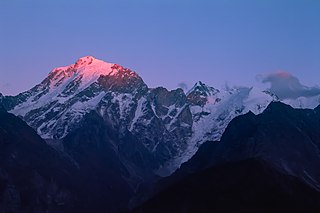
Himachal Pradesh is a state in the northern part of India. Situated in the Western Himalayas, it is one of the thirteen mountain states and is characterized by an extreme landscape featuring several peaks and extensive river systems. Himachal Pradesh is the northernmost state of India and shares borders with the union territories of Jammu and Kashmir and Ladakh to the north, and the states of Punjab to the west, Haryana to the southwest, Uttarakhand to the southeast and a very narrow border with Uttar Pradesh to the south. The state also shares an international border to the east with the Tibet Autonomous Region in China. Himachal Pradesh is also known as Dev Bhoomi, meaning 'Land of Gods' and Veer Bhoomi which means 'Land of the Brave'.

Dharamshala is the winter capital of Himachal Pradesh, India. It serves as administrative headquarters of the Kangra district after being relocated from Kangra, a city located 18 km (11 mi) away from Dharamshala, in 1855.
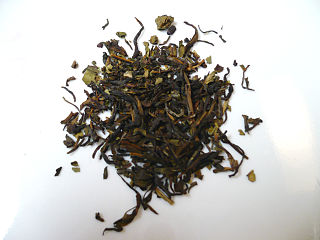
Nilgiri tea is a drink made by infusing leaves of Camellia sinensis that is grown and processed in the Nilgiris district in Tamil Nadu, India. The leaves are processed as black tea, though some estates have expanded their product offerings to include leaves suitable for making green, white and oolong teas. It is generally described as being a brisk, fragrant and full-bodied tea. The region produces both rolled and crush, tear, curl tea and it is predominantly used for blending. Nilgiri tea is also used for making iced tea and instant tea.

Kangra district is the most populous district of the Indian state of Himachal Pradesh. Dharamshala is the administrative headquarters of the district.

Darjeeling tea is a tea made from Camellia sinensis var. sinensis that is grown and processed in Darjeeling or Kalimpong Districts in West Bengal, India. Since 2004, the term Darjeeling tea has been a registered geographical indication referring to products produced on certain estates within Darjeeling and Kalimpong. The tea leaves are processed as black tea, though some estates have expanded their product offerings to include leaves suitable for making green, white and oolong teas.

Kangra is a city and a municipal council in Kangra district in the Indian state of Himachal Pradesh. It is also known as Nagarkot.
Palampur is a hill station and a municipal corporation situated in the Kangra District in the Indian state of Himachal Pradesh. It is surrounded by pine forests and flanked by the Dhauladhar ranges. There are numerous streams flowing from the mountains to the plains, from Palampur. The combination of greenery, snowclad mountains and water gives Palampur a distinctive look.

Kangra Valley is a river valley situated in the Western Himalayas. It lies in the state of Himachal Pradesh in India, and is a popular tourist destination. The Kangri dialect is spoken there. Dharamshala, the headquarters of Kangra district and the main city of the valley, lies on the southern spur of Dhauladhar.
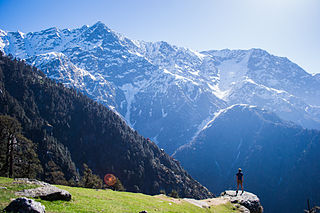
McLeod Ganj, also spelt McLeodganj, is a suburb of Dharamshala in the Kangra district of Himachal Pradesh, India. It is known as "Little Lhasa" or "Dhasa" because of its large population of Tibetans. The Tibetan government-in-exile is headquartered in McLeod Ganj which treats the suburb as its Capital-in-exile.
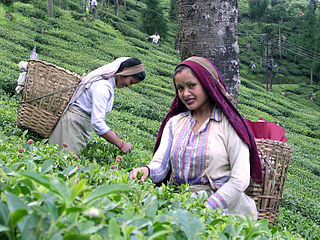
India is one of the largest tea producers in the world, although over 70 per cent of its tea is consumed within India itself. A number of renowned teas, such as Assam and Darjeeling, also grow exclusively in India. The Indian tea industry has grown to own many global tea brands and has evolved into one of the most technologically equipped tea industries in the world. Tea production, certification, exportation, and all other facets of the tea trade in India are controlled by the Tea Board of India.

India is the second largest producer of tea in the world after China, including the famous Assam tea and Darjeeling tea. Tea is the 'State Drink' of Assam. Following this the former Planning Commission Deputy Chairman, Montek Singh Ahluwalia had plans to officially recognise tea as the Indian "National Drink" in 2013. According to the ASSOCHAM report released in December 2011, India is the world's largest consumer of tea, consuming nearly 30% of global output. India is also the second-largest exporter of tea, after China.

The Kangra Valley Railway is a 2 ft 6 in gauge railway that runs from Pathankot, Punjab to Jogindernagar in Himachal Pradesh. It runs through the sub-Himalayan region of Kangra Valley and is 164 km (101.9 mi) long. It is on the UNESCO World Heritage Sites tentative list. The railway is part of the Firozpur division of Northern Railway. It is the longest Narrow Gauge line in India and also the longest 2 ft 6 in Gauge Railway in the World. The highest point on this line is Ahju station at an elevation of 1,290 meters (4,230 ft). There are 33 stops and 950 bridges.
Bhawarna is a town in Kangra district, Himachal Pradesh, India. 11 kilometres (6.8 mi) from Palampur. The postal code for Bhawarna is 176083.
Maranda is a suburb in Palampur City on the Kangra district in Indian state of Himachal Pradesh, India. Dharamshala is the administrative headquarters of the Kangra district.

Black tea, is a type of tea that is more oxidized than oolong, yellow, white and green teas. Black tea is generally stronger in flavour than other teas. All five types are made from leaves of the shrub Camellia sinensis, though Camellia taliensis is also used rarely.

The black pottery of Nizamabad in Azamgarh district of Uttar Pradesh, India is unique type of clay pottery known for its dark shiny body with engraved silver patterns. It was registered for Geographical Indication tag in December 2015.

Coorg orange, also called Coorg mandarin, is a cultivar of orange from Kodagu in Karnataka. It was given the Geographical Indication status in 2006.
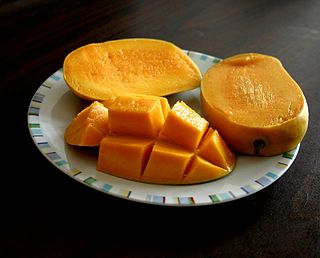
The 'Gir Kesar' mango, also called Kesar, is a mango cultivar grown in the foothills of Girnar in Gujarat, western India. The mango is known for its bright orange colored pulp and was given the geographical indication status in 2011. The biggest market of Gir Kesar is in Talala Gir known as a Mango Market Yard.
Ashish Butail is an Indian politician, tea planter and entrepreneur. He belongs to the Indian National Congress party, and has been elected to the Himachal Pradesh Legislative Assembly from Palampur since 2018. He currently serves as Chief Parliamentary Secretary in Chief Minister Sukhvinder Singh Sukhu’s cabinet.

Sikkim tea is a variety of tea grown in the state of Sikkim, India. Though Sikkim tea is not as widespread in use as the neighboring Darjeeling tea, it has recently gained more recognition from the increasing demand for organic products. The tea is mostly sold under the marketing name 'Temi tea'. After Darjeeling tea became the first Indian product to receive a GI tag, Sikkim's Temi tea has been waiting to receive the same.